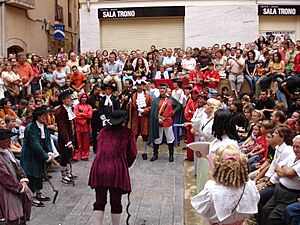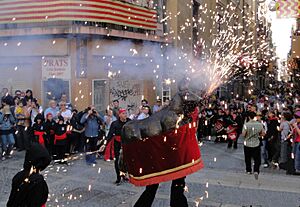Santa Tecla Festival facts for kids
The Santa Tecla Festival (Festes de Santa Tecla) is a big celebration held every year in Tarragona, Catalonia, Spain. It's a special time that connects today's fun with a long history and traditions.
This festival is known for its unique collection of dances, animal figures (called the "bestiary"), short plays (entremesos), and "human castles" (castells). These elements together form the "Popular Retinue," which is the heart of the celebration. The Santa Tecla Festival is so important that the Government of Catalonia calls it a "Traditional Festival of national interest." The Spanish Government also recognizes it as a "Touristic Festival of national interest." It's one of only two festivals in Catalonia to have both these special titles!
Contents
A Look at the Festival's History
People in Tarragona have honored Santa Tecla for a very long time. But the festival as we know it today started to take shape during the Reconquista period. This was when the city's streets became the main place for the celebrations.
In 1091, Pope Urban II made Santa Tecla's day a special holiday. Later, in 1118, when Tarragona was repopulated, Pope Gelasius II confirmed that Santa Tecla's day was the most important festival of the year.
How the Festival Grew
A very important moment happened on May 17, 1321. A special relic, the arm of Santa Tecla, arrived in Tarragona from a place called Antioch. The city gave it an amazing welcome! This event brought everyone out into the streets: leaders, church members, soldiers, and everyday people. It was the first time the whole community came together like this for the festival. New dances, performed by local groups, also started to appear.
In 1370, the "Bylaws of Santa Tecla" were created. These rules were very important for how the festival would be organized. They said that Santa Tecla's festival was as important as the Corpus Christi celebration.
The bylaws set the schedule for the festival. On September 22, people would sing special songs at the Cathedral. Guilds (groups of workers) would perform dances throughout the city in what is now called the Cercavila (a big parade). On September 23, there would be a religious service and a procession. During the procession, the Holy Arm relic would be carried through the streets, led by the dancers.
The bylaws also said that the city's streets should be cleaned and decorated, especially where the procession would pass.
Adding More Fun to the Festival
Over time, more exciting elements were added to the festival.
- From 1381, "fantastic and popular bestiary" (animal figures) appeared.
- By 1385, "biblical characters" joined in.
- In 1399, "lifeless hagiographic characters" (figures of saints) were part of the fun.
- From 1402, "allegorical performance representations" (short plays with a message) were added.
- By the 15th century, roques (moveable platforms like floats) and entremesos (short farces) became part of the celebration.
These additions made the festival more spectacular and complex.
Changes in the 19th and 20th Centuries
The 19th century brought big changes to the Santa Tecla Festival. This was when the famous castells (human towers) became a key part of the celebration. Other important activities also became popular, like the "Matinades" (early morning music with traditional instruments) and the amazing fireworks on Santa Tecla's day. The ringing of the bells and the singing of "goigs" (traditional songs) in the Cathedral also became important. A special character, the Magí de les Timbales (the Council drummer), also became a symbol of the festival.
In the second half of the 19th century, the City Hall introduced its own impressive elements to the Popular Retinue. These included the Moorish Giants, the Black Giants, and the Old Nanos. These giant figures were beautifully crafted. Fireworks also became more important, with lots of noise and light. The Ball de Diables (Devils’ Dance) started to be performed separately from the main parade, which was an early version of today's correfoc (fire run). The sardana dance, from another part of Catalonia, also became popular and started its journey to becoming a national symbol.
The 20th century was a bit challenging for the festival. In 1911, Pope Pius X removed the holiday status of Santa Tecla's day, making it a regular workday. But in 1917, Pope Benedict XV restored it as a holiday after the Town Hall asked him to.
The Spanish Civil War (1936) and the years after made the festival less important. Authorities at the time even tried to promote a smaller festival, Sant Magí, as the main one to attract tourists.
However, with the return of democratic local governments in the 1970s and 1980s, the Santa Tecla Festival was brought back to its full glory. The Popular Retinue was restored, the loud fire displays returned, and the traditional bell ringing was brought back. The music of the gralla and drum also became more widespread. All these efforts helped bring back a cherished city tradition, making the streets a vibrant place for celebration once again.
Images for kids
See also
 In Spanish: Fiestas de Santa Tecla para niños
In Spanish: Fiestas de Santa Tecla para niños




